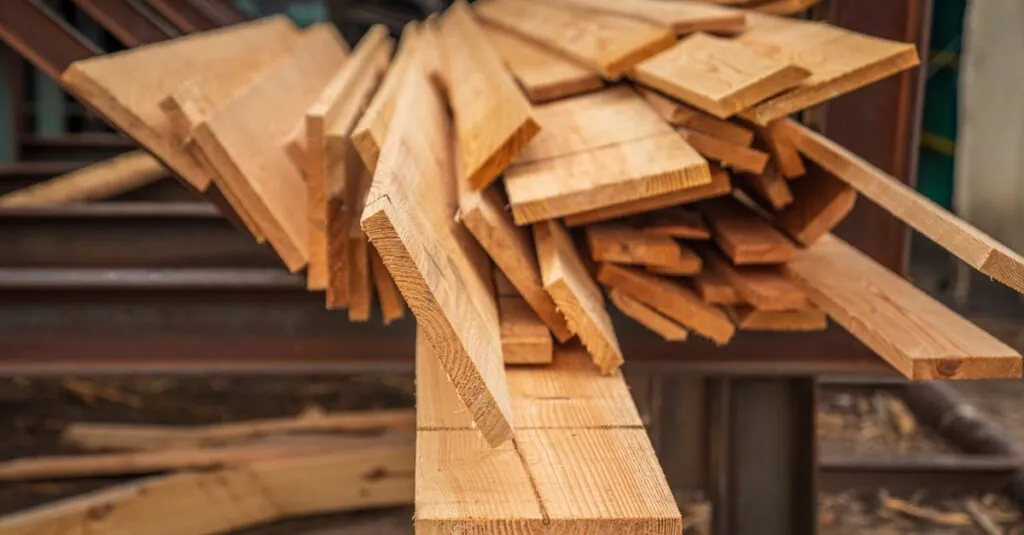In the world of construction, choosing the right build material is like picking the perfect avocado—one wrong move and your entire project could go mushy. Quality matters more than just aesthetics; it’s the backbone of durability and safety. Whether it’s a cozy home or a towering skyscraper, the materials used can make or break the structure.
Table of Contents
ToggleUnderstanding Build Material Quality
Quality in building materials plays a crucial role in construction. Durability, safety, and functionality hinge on the materials chosen. Poor-quality materials compromise structural integrity and lead to costly repairs. Homeowners and builders quantify quality using standards like ASTM (American Society for Testing and Materials) ratings.
Strength contributes to the effectiveness of building materials. For instance, concrete with high compressive strength supports heavy loads, reducing the risk of failure. Fire resistance also matters; materials rated for fire safety protect occupants and property. Selecting materials that meet safety standards, such as UL certification, ensures compliance with fire codes.
Environmental impact cannot be overlooked. Many builders prioritize sustainable materials to minimize carbon footprints. Bamboo, for example, offers an eco-friendly alternative with high durability and rapid renewability. Utilizing recycled materials also supports sustainability goals while maintaining quality.
Cost considerations influence material choices. While high-quality materials often come with a premium price, the long-term savings on maintenance and energy can offset initial costs. Additionally, warranties from manufacturers indicate confidence in the durability of their products, influencing buyer decisions.
Lastly, aesthetic appeal enhances the overall value of a project. Materials that combine beauty with quality, such as natural stone or high-grade wood, elevate design while ensuring functionality. Therefore, understanding and prioritizing build material quality fosters structures that respond to both current needs and future demands.
Key Factors Influencing Build Material Quality
Several critical factors shape the quality of building materials, affecting durability, sustainability, and overall performance in construction projects.
Durability
Durability plays a vital role in building material selection. Materials must withstand environmental factors, such as weathering, temperature changes, and moisture exposure. Structural integrity relies on this longevity, preventing premature wear and maintenance needs. Concrete, steel, and treated wood are examples of materials known for their strength and resistance to decay. High-performance materials often come with ratings from organizations like ASTM, signifying their durability in various applications. Additionally, selecting durable materials reduces the likelihood of costly repairs. Builders quantify performance through rigorous testing, ensuring long-lasting structures that meet safety standards.
Sustainability
Sustainability increasingly influences the choice of building materials. Eco-friendly options contribute positively to the environment, setting a standard for responsible construction practices. Builders often consider renewable resources like bamboo or recycled materials, which minimize ecological impact. Life cycle assessments provide insights into the long-term effects materials have on the environment, guiding selections toward options that promote conservation. Prioritizing sustainability not only meets regulatory requirements but also appeals to environmentally conscious consumers. High-quality sustainable materials support durability while minimizing waste, aligning with modern construction practices aimed at preserving natural resources.
Types of Build Materials
Selecting appropriate build materials affects durability, functionality, and aesthetics. Different materials serve various purposes in construction projects.
Wood
Wood remains a popular choice due to its versatility. It provides natural insulation, which can enhance energy efficiency. Different types of wood offer varying levels of strength and durability. Treated wood, for instance, withstands moisture and pests effectively. The aesthetic appeal of wood can elevate any structure’s design. Builders often prefer locally sourced lumber to reduce ecological footprints while promoting sustainability. Cost considerations also come into play, as wood can be an economical option for many projects.
Concrete
Concrete is widely used for its strength and durability. It withstands harsh environmental conditions, making it ideal for foundations and pavements. This material can be molded into various shapes, offering design flexibility. Additionally, high-performance concrete mixes improve longevity and reduce maintenance needs. Though concrete may require a higher upfront investment, its longevity leads to overall cost savings. The use of recycled aggregates in concrete mixes increasingly aligns with sustainability goals in construction.
Steel
Steel stands out for its exceptional strength-to-weight ratio. Many builders appreciate steel for its ability to support large structures without excessive material usage. Corrosion-resistant treatments enhance steel’s durability, making it suitable for exposed applications. Performance in seismic areas makes steel a popular choice for buildings in earthquake-prone regions. Costs of steel fluctuate with market conditions, yet its long lifespan often justifies the initial expense. Incorporating recycled steel provides an eco-friendly option, contributing to sustainable construction practices.
Importance of Assessing Build Material Quality
Assessing build material quality influences construction outcomes significantly. Quality directly impacts durability, safety, and overall functionality. Poor material choices may result in compromised structures and unplanned expenses. Builders rely on established standards, such as ASTM ratings, to measure quality.
Strength defines how well materials withstand stress and wear over time. Fire resistance also plays a vital role in determining safety during emergencies. Compliance with safety regulations ensures structures meet required performance levels. Increasingly, the environmental impact of materials becomes a central consideration. Sustainable options, including bamboo and recycled resources, offer choices that benefit both users and the planet.
Cost should not overshadow quality during material selection. While high-quality materials might incur higher initial expenses, they often translate into long-term savings. Aesthetic appeal enhances property values and overall satisfaction. Materials combining beauty with quality elevate design while ensuring durability.
Durability and sustainability are crucial factors in assessing material quality. Structures must endure environmental stresses, such as weather changes and moisture exposure. High-performance products, like treated wood and specialized concrete, gain recognition for their longevity. Sustainability attracts attention, aligning with modern practices that emphasize resource preservation.
Different material types serve specific construction functions, impacting assessments. Wood provides versatility coupled with natural insulation benefits. Concrete boasts strength, ideal for foundations and surfaces requiring robustness. Steel remains a top choice due to its superior strength-to-weight ratio and corrosion resistance, making it suitable for challenging environments.
Each material contributes distinct advantages, underlining the importance of careful selection to achieve optimal results. By prioritizing quality in materials, builders promote safer, more sustainable, and aesthetically pleasing structures, ensuring projects meet the demands of today while preparing for future needs.
Prioritizing build material quality is essential for any construction project. The right materials ensure durability safety and aesthetic appeal while minimizing long-term costs. Builders and homeowners alike must consider not only the immediate benefits of high-quality materials but also their impact on sustainability and structural integrity. By making informed choices based on established standards and modern practices builders can create structures that stand the test of time. Investing in quality materials today leads to greater value and performance tomorrow.




